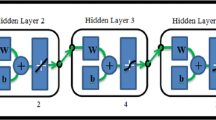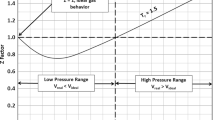Abstract
The development of gas condensate reservoirs relies strongly on the accuracy of pressure–volume–temperature (PVT) data. The produced volumes of gases and liquids can be predicted, under different conditions, using PVT relationships. Also, the design of surface facilities such as storage tanks and fluids separators requires detailed information about the PVT behaviors. However, measuring the PVT properties is costly and time-consuming. Therefore, this work presents a quick and reliable approach to evaluating the PVT properties for gas condensate reservoirs using artificial intelligence techniques. Constant volume depletion (CVD) data were collected from different wells. More than 1000 data sets were collected from 68 wells that cover wide ranges of fluid compositions and reservoir conditions. The collected data contain mole fractions of gas condensate components, pressure relative volume, and reservoir temperature. First, data cleaning was performed to remove the outliers utilizing the standard deviations technique. Thereafter, artificial neural network (ANN), adaptive neuro-fuzzy inference system (ANFIS), and support vector machines (SVM) were used to develop new models to predict the performance of CVD tests. Different evaluation indexes were used to assess the reliability of the developed models; root–mean–square error and correlation coefficient (R2) were used. The obtained results showed that ANN model outperforms ANFIS and SVM techniques in predicting the PVT behavior. The values of coefficient of determinations are 0.995, 0.959, and 0.948 for the testing data using ANN, ANFIS, and SVM models, respectively. The root-mean-square error was reduced from around 1.20 to less than 0.5 using the ANN model, for the testing data set. Additionally, a new correlation was developed using the ANN technique to predict the CVD performance. The new correlation showed a very acceptable accuracy and less estimation errors compared to the available models. Ultimately, this work introduces a new approach to saving time and effort in determining the PVT behavior. A new correlation is presented to provide a direct and simple approach for estimating CVD performance.








Similar content being viewed by others
References
Alakbari FS, Fahd K, Elkatatny S, Unversity KF (2016) SPE-184208-MS prediction of bubble point pressure using artificial intelligence ai techniques prediction of BPP
Al-sirri D, Gharbi R (2011) Predicting lower fares heavy oil molar compositions using artificial neural networks. In: Presented at the SPE heavy oil conference and exhibition, Kuwait City, Kuwait, 12–14 December. SPE-150365-MS. https://doi.org/10.2118/150365-MS
AlMatouq H (2016) Molecular weight correlation for crude oil in the fields of Saudi Arabia. In: Presented at the SPE heavy oil conference and exhibition, Kuwait City, Kuwait, 6 December. SPE-184113-MS. https://doi.org/10.2118/184113-MS
Ahmed T (2016) Equations of state and PVT analysis: applications for improved reservoir modeling: Second Edition. Equations of state and PVT analysis: applications for improved reservoir modeling: Second Edition. https://doi.org/10.1016/C2014-0-00119-0
Al-Marhoun MA, Osman EA (2002) Using artificial neural networks to develop new PVT correlations for Saudi crude oils. In: Society of petroleum engineers—Abu Dhabi international petroleum exhibition and conference 2002, ADIPEC 2002. https://doi.org/10.2523/78592-ms
Alarfaj MK, Abdulraheem A, Busaleh YR (2012). Estimating dewpoint pressure using artificial intelligence. In: Society of petroleum engineers—SPE Saudi Arabia section young professionals technical symposium 2012, YPTS 2012, pp 27–36. https://doi.org/10.2118/160919-ms
Akpabio JU, Udofia EE, Ogbu M (2014) PVT fluid characterization and consistency check for retrograde condensate reservoir modeling. In: SPE Nigeria annual international conference and exhibition. Society of Petroleum Engineers
Ahmed, T. (2016). Equations of State and PVT Analysis: Applications for Improved Reservoir Modeling: Second Edition. Elsevier https://doi.org/10.1016/C2014-0-00119-0
Elkatatny S, Alakbari FS, Baarimah SO (2017) Prediction of bubble point pressure using artificial intelligence AI techniques. In: Society of petroleum engineers—SPE middle east artificial lift conference and exhibition 2016. pp 329–337. https://doi.org/10.2118/184208-ms
Elkatatny S, Mahmoud M (2018) Development of a new correlation for bubble point pressure in oil reservoirs using artificial intelligent technique. Arab J Sci Eng 43(5):2491–2500. https://doi.org/10.1007/s13369-017-2589-9
Elsharkawy AM (1998) Modeling the properties of crude oil and gas systems using RBF network. In: Presented at the SPE Asia Pacific oil & gas conference, Perth, Australia, October 12–14. SPE 49961-MS. https://doi.org/10.2118/49961-MS
Elsharkawy AM, Foda SG (1998) EOS simulation and GRNN modeling of the constant volume depletion behavior of gas condensate reservoirs. Energy Fuels 12(2):353–364
Gharbi RBC, Elsharkawy AM (1999) Neural network model for estimating the PVT properties of middle east crude oils. SPE Reserv Eval Eng 2(3):255–265. https://doi.org/10.2118/56850-PA
Humoud AA, Al-Marhoun MA (2001) A new correlation for gas-condensate dewpoint pressure prediction. In: Proceedings of the middle east oil show, pp 877–884. https://doi.org/10.2523/68230-ms
Hurst W (1973) The material balance equation. Petroleum Reservoir Engineer, Houston
Hassan A, Abdulraheem A, Mohamed A (2020) Reliable models for determining the pressure-volume-temperature PVT properties using artificial intelligence technique. In: International petroleum technology conference
Matthews TA, Roland CH, Katz DL (1942) High Pressure Gas Measurement. Pet Refin 21(6):58–70
Nilsson NJ (1980) Principles of artificial intelligence. Morgan Kaufmann, LOS Altos
Nemeth LK, Kennedy HT (1967) A correlation of dewpoint pressure with fluid composition and temperature. Soc Petrol Eng J 7(2):99–104. https://doi.org/10.2118/1477-pa
Osman EA, Abdel-Wahhab OA, Al-Marhoun MA (2001) Prediction of oil PVT properties using neural networks. In: Proceedings of the middle east oil show, pp 893–906. https://doi.org/10.2523/68233-ms
Rammay MH, Abdulraheem A (2017) PVT correlations for Pakistani crude oils using artificial neural network. J Pet Explor Prod Technol 7(1):217–233
Whitson CH, Fevang Ø, Yang T (1999) Gas condensate PVT–what’s really important and why?. In: IBC conference, London, UK, pp 28–29
Yao X (1999) Evolving artificial neural networks. In: Proceedings of the IEEE, vol 87, no 9, pp 1423–1447, Sept. 1999. https://doi.org/10.1109/5.784219
Acknowledgements
The authors would like to acknowledge the College of Petroleum Engineering & Geosciences (CPG) at King Fahd University of Petroleum & Minerals (KFUPM) for establishing the required environment for research.
Author information
Authors and Affiliations
Corresponding author
Ethics declarations
Conflict of interest
The authors declare no conflict of interest.
Additional information
Publisher's Note
Springer Nature remains neutral with regard to jurisdictional claims in published maps and institutional affiliations.
Rights and permissions
Springer Nature or its licensor holds exclusive rights to this article under a publishing agreement with the author(s) or other rightsholder(s); author self-archiving of the accepted manuscript version of this article is solely governed by the terms of such publishing agreement and applicable law.
About this article
Cite this article
Ahmed, M.E., Sultan, A.S., Hassan, A. et al. Predicting the performance of constant volume depletion tests for gas condensate reservoirs using artificial intelligence techniques. Neural Comput & Applic 34, 22115–22125 (2022). https://doi.org/10.1007/s00521-022-07682-8
Received:
Accepted:
Published:
Issue Date:
DOI: https://doi.org/10.1007/s00521-022-07682-8




